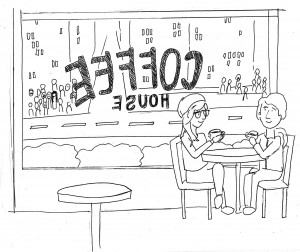Gentrification displaces people, cultures
Gentrification hurts. Nobody knows this better than Mercedes Cortes, a Guatemalan immigrant who settled in Hollywood in the 1960s with her husband and three sons.
According to an L.A. Weekly profile, Cortes’ apartment on Eleanor Avenue near the intersection of Santa Monica Boulevard and Vine Street was threatened by rampant violence in the 1980s, so she, along with several of her neighbors, formed and enforced a strict neighborhood watch program that worked successfully to ensure that their neighborhood could be called safe.
Cortes’ efforts were lauded, and she and her neighbors were proud that their efforts to improve their neighborhood were remarkable enough to help prompt a revitalization of Hollywood. But what Cortes didn’t realize was that her work to help save her neighborhood from gangs and crime would ultimately be a part of the reason she had to move away.
In 2004, Cortes was asked to leave her neighborhood of 30 years — the one she and others had worked so hard to ensure was a livable, thriving community. The reason? Simply put, Cortes could not pay her rent.
Hollywood has been widely labeled as a “neighborhood on the rise” for the past decade or so. The policies of 13th District Councilman Eric Garcetti have done well to ensure that Hollywood, as well as other neighborhoods such as Silver Lake, East Hollywood and Echo Park, are part of an end goal of “urban renewal.”
That goal often involves public projects aimed at attracting higher-income individuals to the area, including the redevelopment or destruction of older housing, which is detrimental to low-income individuals living in these urban-renewal areas. For example, expensive projects such as Hollywood Lofts and Jefferson at Hollywood now exist on space that was, less than a decade ago, home to high-density, low-income apartment buildings.
But Hollywood’s gentrification affects more than just those who live in buildings slated for destruction.
Between 2000 and 2010 — the years of the last two U.S. census counts — Hollywood and East Hollywood witnessed a population decrease of 12,878 people. Of these people, approximately 11,000 are identified as low-income Latinos.
Larry Gross, the executive director of the Coalition for Economic Survival, a tenants’ rights advocacy group, informed L.A. Weekly how the census data in Hollywood reflects “an economic tsunami that pushed low-income people out. There was massive displacement.”
This trend is occurring in other parts of the city as well. Take, for example, census tract 1974.20. Bordered by Glendale and Sunset boulevards to the west and south and Avalon Street and Echo Park Avenue to the north and east, 1974.20 is an Echo Park census tract that did not change boundaries between 2000 and 2010.
Over the course of the last decade, tract 1974.20 witnessed an increase of just 200 white residents. The same tract in Echo Park witnessed an exodus of about 1,000 Latino individuals in the same amount of time.
This is the true story of gentrification, one that those who move into gentrified neighborhoods most often don’t hear.
Gentrification drives up the cost of living in areas of the city that were previously more affordable for low-income individuals. For Cortes, most of her time living on Eleanor Avenue was done so at a rent that she could afford.
But as Hollywood became marked for urban revitalization, and the area surrounding her apartment building was redeveloped into residences that attracted higher-income individuals, the rent in her building went up too. Her manager understood that the area was now prime real estate for people who could afford to pay more than Cortes. With this in mind, it made logical business sense to increase the rent to a level comparable to what new people moving into the area would be able to pay.
Though it’s likely that forcing out low-income individuals is not an end goal, the desire to attract people with higher incomes automatically means that individuals who cannot afford the high rents are pushed out.
I don’t believe this is a desirable result. Urban renewal implies genuinely changing an area for the better and not simply replacing poor Latinos with coffee shops. One can hope that future developments in the city are done more responsibly, but the very nature of gentrification implies they won’t be.
Matthew Tinoco is a freshman majoring in print and digital journalism and comparative literature. His column “Mixing Colors” ran Mondays.

